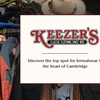“As I approached, the band of freshmen seemed to open up so that I could enter the tribal circle,” wrote T. Apollo Whitbread ’80. “As I penetrated the circle I saw six or seven leaders dressed in sheets jumping up and down in a frenzy, screaming in timely unison. ‘Toga! Toga! Toga!’ in between guzzles of beer.”
At the end of September, seven seniors in Leverett House organized an upperclass toga event and promised of revelry lasting until dawn. But the Saturday party, according to a Crimson article a few days later, was largely a bust, failing to live up to the Animal House model on which it had been based.
“Since no one was sufficiently familiar with the rites of Toga, participants behaved according to American ’70s custom,” wrote Crimson reporter J. Wyatt Emmerich ’80. “Occasionally someone would chase a friend through the crowd threatening affectionately to straighten her (his?) toga or die trying, but onlookers just smiled timidly and continued to sip their punch.”
‘THE EXTRA MILE’
By the time Harvard-Yale weekend rolled around, though, a group of students opened the doors to a toga party they hoped would put one of Harvard’s least popular Houses on the map. A party in South House, now part of Cabot, held in November 1978 carried the toga craze to its peak on campus, drawing throngs of students—and troupes of police officers—to the southern edge of the Quad for what became the most notorious weekend of the year.
“We had to go the extra mile to prove that it was okay to live at South House,” Carroll explains. “No one wanted to be there.”
In a period before the present housing lottery, students could submit their top three choices for upperclass housing in the spring of their first year. Nearly 80 percent were assigned to one of these Houses, according to Winthrop, a South House resident, but the remaining 20 percent of the first-years invariably ended up in the least coveted locations—and this generally meant the Quad.
He recalls knowing only about five students in South House who had initially wanted to live there. But as the possibility of joining the majority of the student body in one of the coveted River Houses faded, Winthrop and his housemates began devising plans to bring the rest of Harvard’s undergraduates to them.
“The attitude that a lot of us adopted was that if we’re here, we might as well make the most of it,” he says.
With Animal House released just a few months before and the toga craze sweeping the country, one route to popularity seemed obvious. Winthrop, who was then a House Committee chair, joined with a few of his colleagues to organize what they hoped would be Harvard’s biggest toga bash.
The planners left no stone unturned. They started a massive publicity campaign, putting up flyers with a picture of Belushi spilling mustard on himself on every available Harvard kiosk and at other local colleges. They hung “Toga at Soho” banners. They even hired a plane to fly an advertising banner over one of the Crimson’s home games.
Admission to the toga event would only be a dollar, they said, and proceeds would be donated to the Jimmy Fund for cancer research.
The party seemed to be on the fast track to success until the planners announced their hope to accept donations from private companies.
The College administration feared a slippery slope of corporate sponsorship making its way into Harvard, and forbade the party sponsors to accept the promotional material, along with several kegs of then-new Busch beer that the Anhauser-Busch company had offered in exchange for logo space on party banners.
With a contribution from House Master Warren E.C. Wacker, the planners brought beer nonetheless, and set up a toga-rental booth near the money-collection table by the door.
Read more in News
POLICE LOG












